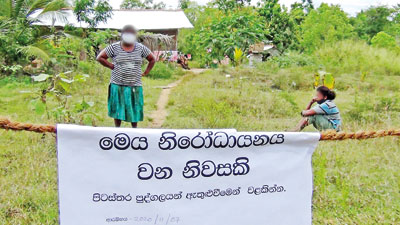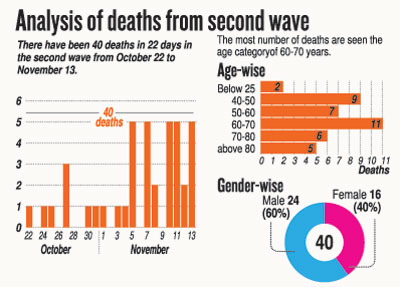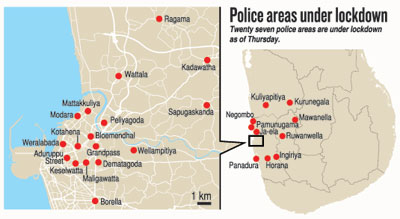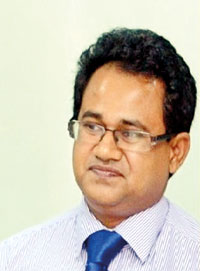News
Help us flatten the COVID-19 peak, plea to the public
Strong efforts are being made to limit the spread of COVID-19, reiterated health officials, urging people to join them in this effort.
Comparing the current situation to the first wave, the Deputy Director-General (Public Health Services I), Dr. Hemantha Herath said that the different clusters in that, at some point, reached a peak. Thereafter, due to the measures taken the peak began reducing.
“In this second wave, with the country at Alert Level 3, we are making a concerted effort to beat down the rising peaks in the different clusters and flatten them, after which we can work towards getting the numbers down further,” he said.
Dr. Herath repeats the mantra – reducing the spread – which would lead to the flattening of the line and curbing the rapid rise or incremental increases. The essential measures are restricting movement, detecting positive COVID-19 cases as much as possible and isolating them and going in search of their contacts and isolating them as well.

Anamaduwa: A notice informing area residents of a house that has been placed under quarantine.Pic by Hiran Priyankara
“This is what we are doing,” he says, sending out an earnest request to the people to do their part in these control efforts by resorting to hand hygiene, wearing a face-mask, keeping a metre distance from others and avoiding crowded places.
Criteria for lockdowns
When asked on what criteria a village or area is declared as isolated or locked down, he explained that it was a decision made after studying the risk factors. One factor would be whether the caseload of COVID-19 positive people is high, while another would be whether the people’s behaviour (they tend to gather together) necessitates such a move.
Referring to the deaths (40 deaths in 22 days in the second wave), Dr. Herath pointed out that they have been at high-risk in succumbing to COVID-19 because of co-morbidities (other chronic diseases like diabetes, kidney or heart disease etc.)
“While all of us should be careful and protect ourselves, those at risk should be given extra protection. This is why they should restrict their movements and stay home as much as possible,” he said, adding however that even this would not be adequate if their family members are not careful too. 
Rapid Antigen Test kits & handling of bodies
Meanwhile, commenting on two other issues – the Rapid Antigen Test and cremation of those who die of COVID-19, Dr. Herath said that the test kits are being validated in Sri Lanka and would be used here only if they have good results.
With regard to cremations, he added: “There is an expert committee including virologists, microbiologists, forensic pathologists and epidemiologists who decide on how these bodies should be handled.
Currently, these bodies are being cremated but these experts review emerging scientific evidence and as such these guidelines may be subjected to change depending on such evidence.”

Comparing and contrasting RT-PCR & Rapid Antigen Tests  Dr. Rohitha Muthugala To get an insight into RT-PCR tests and Rapid Antigen Tests, the Sunday Times contacted Consultant Virologist Dr. Rohitha Muthugala of the Kandy Teaching Hospital. RT-PCR (Reverse-Transcription Polymerase Chain Reaction) test – The test specimens are from nasopharyngeal (upper part of the throat) and oro-pharyngeal (middle part of the throat) swabs. Checks the viral RNA (ribonucleic acid) through an enzyme reaction by amplifying a small amount of RNA. Overall, the sensitivity is 70%, but if the infection is in the upper-respiratory tract, it is 80-90% sensitive and if the infection is in the lower-respiratory tract, it is 60-70% sensitive. Time-wise the testing takes about 4 hours without considering the specimen preparation time. The testing is done in batches (not individually), in 24, 48 or 96-specimen batches. The advantage is that the test can even find a low viral load but sometimes by that time the patient may not be infective (capable of causing infection). It is a technically difficult test to do and could exhaust both the required material and personnel handling it. It needs a sophisticated laboratory with the personnel needing specialized training. The cost is high. Rapid Antigen Test – The test specimens are from nasopharyngeal swabs. Checks the viral protein (the jutting out spikes of the virus). There is no amplification involved. Sensitivity is very high when the viral load is high and low when the viral load is low. Time-wise, it takes only about 20 minutes. The testing can be done individually. As the test finds those having a high viral load, it is good to identify them as they are very infectious at this time. It is a relatively easy test to carry out. It does not need a sophisticated laboratory and can be carried out in a field setting. The cost is low. Dr. Muthugala added that the RT-PCR Test is the gold standard in diagnosing patients, while the Rapid Antigen Test can be used as a screening tool to detect patients who are in the infectious period, making this an advantage.
| |
| Army drones to be used in epidemics The newest wing of the Sri Lanka Army, the 15th Drone Regiment of the Sri Lanka Artillery (SLA) equipped with high-tech cameras that enable operations within short and medium distances and quadcopters with observation cameras for surveillance purposes is to be used not only in war scenarios but also soft operations such as natural and man-made disasters and epidemics like COVID-19.
| |
| COVID-19 in five prisons Five main prisons have fallen like dominoes to the coronavirus, with 148 prisoners and four staff members being affected. “The Welikada, Bogambara, Matara, Kuruwita and Colombo Remand Prisons of the 29 prisons countrywide have been affected by the second wave of COVID-19,” confirmed the Commissioner of Prisons (Administration and Rehabilitation), Chandana Ekanayake on Wednesday night. The positive cases were detected through random but regular RT-PCR testing in the first week of November, it is learnt. Ninety-four of those who have tested positive are women and 54 are men. The breakdown of numbers is: Welikada – 20 men, 92 women and two staff members; Bogambara – 30 men and two staff members; Matara: — one woman; Kuruwita – one woman; and Colombo Remand – 4 men. All those who have tested positive have been sent to the National Institute of Infectious Diseases (NIID), Angoda, and their close contacts into quarantine at an isolation centre demarcated at the Angunukolapelessa Prison premises. All new remandees from various courthouses are sent into quarantine at the Bogambara Prison which has been turned into a quarantine centre. The Commissioner said that those being released from prison undergo RT-PCR testing to ensure that they are not taking the virus into the community. The Public Health Inspector (PHI) and police station in the area where the released prisoner lives are informed about his/her return home. When the Sunday Times asked about reports that remandee A.K. Fathima Hadiya, the wife of the alleged Easter Sunday attack mastermind, Zahran Hashim, had tested positive, Mr. Ekanayake declined to give information on individuals. They have yet not found how the virus got into the prisons, he said, explaining that a possibility could be staff coming in and going out, as they have to go back home. He conceded that overcrowding in prisons is a problem. Even though all the prisons can only accommodate 11,000, there are 32,000 prisoners currently. As such, keeping a metre distance between prisoners is impossible and this leads to high transmissibility if the virus gets in. They are making an effort through the court system to reduce the number of people being sent to prison by granting bail to those who have been charged with having in their possession less than 1 gram of narcotics and sending those charged with drug-related offences to rehabilitation centres such as Kanadakadu, said Mr. Ekanayake. Since the positive cases detected in the prisons are high, the staff is working on a roster basis and has been requested to stay in quarters in the prison. The shift rotation is every 14 days. Contact with the outside has been limited and suppliers only allowed in certain areas of the prison, it is understood. At the time of going to press, the number of prisoners affected by COVID-19 had risen to 159.
| |
| Lockdowns/isolated areas & so-called deaths on the roadsTwenty seven police areas are in lockdown/isolation. (See graphic above)“The decision to impose a lockdown/isolation of an area is taken by the Health Ministry’s Epidemiology Unit, while the police implement it,” said Deputy Inspector General (DIG) of Police Ajith Rohana. In such a situation, he said that people are not allowed to leave their homes under any circumstances. The exceptions to the strict travel restrictions are emergencies such as needing hospital services. Under these circumstances, people can access hospital services in their private vehicles and they do not need permission to do so. They can also call for an ambulance. When asked about social media posts of people dying of COVID-19 on the roads, Mr. Rohana said they were false. Investigations are underway to find who is spreading this fake news, so that action could be taken against them. A beggar had died on the road and they were not sure of what the cause of death was but believed it to be due to natural causes. An RT-PCR test done before the postmortem had been positive, he added. Meanwhile, Public Health Inspectors’ (PHIs’) Union Secretary M. Balasooriya said that decisions to lockdown/isolate an area, would centre around the epidemic status, the disease distribution, the number of contacts from a positive patient and where a positive patient may have travelled to. They would be a result of discussions with the area police, the Medical Officer of Health, the PHI and the Grama Niladhaari, followed by the provincial committee and then at national level, he added. For an ambulance, |

